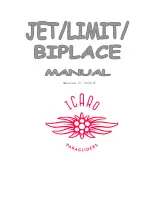
24
Check main line lengths inclusive risers and quick links after 100 flight hours or after tree or
water landings. Lines can stretch or shrink. If you suspect that the flight features of your
paraglider have changed, contact MAC PARA or an authorised supplier as soon as
possible.
Don't tie any unnecessary knots in the lines. Packing methods where special knots are
made in the lines as used on parachutes and reserve parachutes are not suitable for
packing the lines used on paragliders.
Never drag the wing over rough ground! This will damage the cloth on the wear points.
When preparing the wing on a take-off with rough ground, don’t pull the wing over it (i.e. by
pulling the brakes). Please try to pack the wing on soft ground.
Uncontrolled strong wind take-offs or landings can result in the leading edge of the canopy
hitting the ground at high speed which may cause rips in the profile and damage the rib
material. Any repairs on paragliders are very expensive.
Clean the paraglider with fresh water after contact with salt water. Salt water crystal can
reduce line strength, even after rinsing in fresh water. Replace lines immediately after
contact with salt water. Also check canopy material after water landings, as waves can
place uneven forces and cause cloth to distort in specific areas. Always remove gliders
from the water by holding only the trailing edge.
Clean the paraglider with water and a soft sponge. Do not use any chemicals or spirits for
cleaning, as these can permanently damage the cloth
.
Do not pack your glider too tightly after use and, even though it is very comfortable, never
sit on the backpack with the glider inside.
Maintenance
Identification label
MAC PARA gliders have an identification label on central rib. It is helpful to provide the
type designation of the paraglider if you are contacting your MAC PARA dealer with any
queries or ordering replacement parts or accessories, to ensure accurate identification.
Regular inspections
Risers and quick-links, lines and fabric must be inspected regularly for damage, abrasion
and correct operation.
Tissue and Canopy check
A full visual check should be carried out: All the components of the wing (stitching, ribs,
diagonals, lines, tabs, etc.) should be checked for signs of deterioration.
The tearing resistance of the cloth - A non-destructive test following the TS-108 standard
which specifies minimum tear strength for sky diving canopies should be made using a
Bettsometer. (B.M.A.A. Approved Patent No. GB 2270768 Clive Betts Sails).
Summary of Contents for Pasha 7
Page 1: ...1 ...
Page 29: ...29 LINE PLAN PASHA 7 ...
Page 34: ...34 CHECKS Name Company Date Signature Stamp ...
Page 36: ...36 ...







































